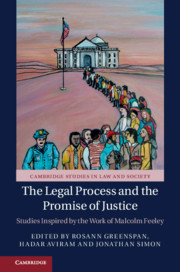Book contents
- The Legal Process and the Promise of Justice
- Cambridge Studies in Law and Society
- The Legal Process and the Promise of Justice
- Copyright page
- Contents
- About the Contributors
- Introduction: Past as Prologue
- Part I The Process Is the Punishment
- Part II Court Reform on Trial
- 5 Regulating E-Cigarettes: Why Policies Diverge
- 6 Japanese Court Reform on Trial
- 7 Court Reform and Comparative Criminal Justice
- 8 The Birth of the Penal Organization: Why Prisons Were Born to Fail
- 9 The Misbegotten: Infanticide in Victorian England
- Part III Judicial Policymaking and the Modern State
- Part IV Political Liberalism and the Legal Complex
- Index
- Books in the Series
- References
6 - Japanese Court Reform on Trial
from Part II - Court Reform on Trial
Published online by Cambridge University Press: 18 April 2019
- The Legal Process and the Promise of Justice
- Cambridge Studies in Law and Society
- The Legal Process and the Promise of Justice
- Copyright page
- Contents
- About the Contributors
- Introduction: Past as Prologue
- Part I The Process Is the Punishment
- Part II Court Reform on Trial
- 5 Regulating E-Cigarettes: Why Policies Diverge
- 6 Japanese Court Reform on Trial
- 7 Court Reform and Comparative Criminal Justice
- 8 The Birth of the Penal Organization: Why Prisons Were Born to Fail
- 9 The Misbegotten: Infanticide in Victorian England
- Part III Judicial Policymaking and the Modern State
- Part IV Political Liberalism and the Legal Complex
- Index
- Books in the Series
- References
Summary
Court reform is on trial in Japan and two things can be said about the verdict: it will take at least several more years to make a sound assessment of the recent changes, and when the conclusion comes, it will be a hung jury, because different people expect different things from the reforms – and they are not compatible.
- Type
- Chapter
- Information
- The Legal Process and the Promise of JusticeStudies Inspired by the Work of Malcolm Feeley, pp. 122 - 138Publisher: Cambridge University PressPrint publication year: 2019



